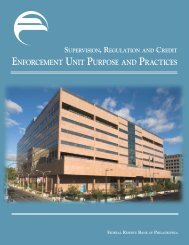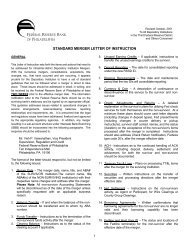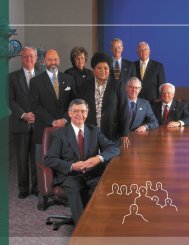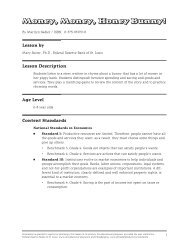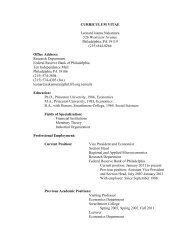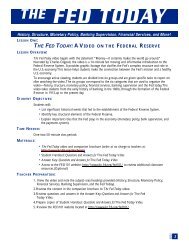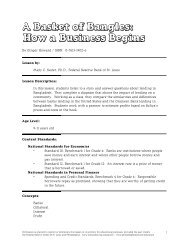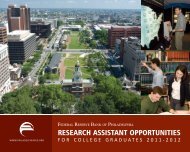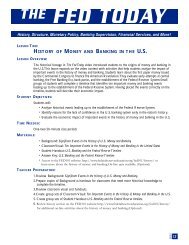The First Bank of the United States - Federal Reserve Bank of ...
The First Bank of the United States - Federal Reserve Bank of ...
The First Bank of the United States - Federal Reserve Bank of ...
You also want an ePaper? Increase the reach of your titles
YUMPU automatically turns print PDFs into web optimized ePapers that Google loves.
TIMELINE FOR THE FIRST BANK OF THE UNITED STATES<br />
4<br />
1790<br />
Alexander<br />
Hamilton<br />
submits a report<br />
to Congress<br />
outlining his<br />
proposal for a<br />
national bank.<br />
1791<br />
In February,<br />
President<br />
Washington signs<br />
<strong>the</strong> bill establishing<br />
<strong>the</strong> <strong>Bank</strong> <strong>of</strong> <strong>the</strong><br />
<strong>United</strong> <strong>States</strong>.<br />
<strong>Bank</strong> Operations<br />
<strong>The</strong> <strong>Bank</strong> <strong>of</strong> <strong>the</strong> <strong>United</strong> <strong>States</strong>, now<br />
commonly referred to as <strong>the</strong> <strong>First</strong> <strong>Bank</strong>, opened for<br />
business in Philadelphia on December 12, 1791, with<br />
a 20-year charter. <strong>The</strong> <strong>of</strong>fice was initially housed in<br />
Carpenters’ Hall and remained <strong>the</strong>re until <strong>the</strong> bank<br />
moved to new quarters on Third Street six years later.<br />
Branches opened in Boston, New York, Charleston,<br />
and Baltimore in 1792. 11 (See <strong>The</strong> <strong>First</strong> <strong>Bank</strong> Building:<br />
Still Standing After All <strong>The</strong>se Years, page 11.)<br />
<strong>The</strong> bank started with capitalization <strong>of</strong><br />
$10 million, $2 million <strong>of</strong> which was held by <strong>the</strong><br />
government and <strong>the</strong> remaining $8 million by<br />
private investors. 12 By <strong>the</strong> standards <strong>of</strong> <strong>the</strong> day, this<br />
was a very large amount <strong>of</strong> money. <strong>The</strong> size <strong>of</strong> its<br />
capitalization made <strong>the</strong> <strong>First</strong> <strong>Bank</strong> not only <strong>the</strong> largest<br />
financial institution in <strong>the</strong> new nation but also <strong>the</strong><br />
largest corporation <strong>of</strong> any type by far. <strong>The</strong> bank’s<br />
sale <strong>of</strong> shares was also <strong>the</strong> largest initial public<br />
11 Between 1800 and 1805, four more branches were established in<br />
Norfolk (1800), Savannah (1802), Washington, D.C. (1802), and New<br />
Orleans (1805).<br />
12 Although estimates vary, today $10 million would be more than<br />
$220 million according to John McCusker’s composite commodity<br />
price index. See his publication.<br />
<strong>The</strong> <strong>First</strong> <strong>Bank</strong> <strong>of</strong> <strong>the</strong> <strong>United</strong> <strong>States</strong><br />
1791<br />
In July, <strong>Bank</strong><br />
subscriptions <strong>of</strong><br />
stock go on sale<br />
and sell out within<br />
hours.<br />
1791<br />
In December, <strong>the</strong><br />
<strong>Bank</strong> <strong>of</strong> <strong>the</strong> <strong>United</strong><br />
<strong>States</strong> opens<br />
for business in<br />
Philadelphia.<br />
1792<br />
Branches open in Boston,<br />
New York, Baltimore, and<br />
Charleston.<br />
1792<br />
Secretary <strong>of</strong> <strong>the</strong> Treasury<br />
Hamilton quells <strong>the</strong> panic <strong>of</strong><br />
1792.<br />
1793<br />
In July, <strong>Bank</strong> subscriptions<br />
are fully paid for.<br />
1794<br />
<strong>Bank</strong> acquires<br />
property on south<br />
Third Street on<br />
which it plans<br />
to build new<br />
headquarters.<br />
1797<br />
<strong>Bank</strong> moves<br />
into 116 S.<br />
Third Street;<br />
<strong>the</strong> building<br />
is still <strong>the</strong>re<br />
today.<br />
91 91<br />
92 93<br />
94<br />
95 96<br />
97 98<br />
99 00<br />
<strong>of</strong>fering (IPO) in <strong>the</strong> country to date. Many <strong>of</strong> <strong>the</strong><br />
initial investors were foreign, a fact that didn’t sit<br />
well with many Americans, even though <strong>the</strong> foreign<br />
shareholders could not vote.<br />
Actually, <strong>the</strong> IPO did not <strong>of</strong>fer shares<br />
for immediate delivery, but ra<strong>the</strong>r<br />
subscriptions, or “scrips,” that<br />
essentially acted as a down payment<br />
on <strong>the</strong> purchase <strong>of</strong> bank stock. When<br />
<strong>the</strong> bank subscriptions went on sale in<br />
July 1791, <strong>the</strong>y sold out so quickly that<br />
many would-be investors were left out<br />
and had to try to bid <strong>the</strong>m away from<br />
those fortunate enough to have obtained<br />
<strong>the</strong> scrips. Many borrowed money to do so. Indeed,<br />
demand for bank scrips accompanied by frenzied<br />
borrowing and buying soon led <strong>the</strong> country into a<br />
financial crisis. (See <strong>The</strong> Nation Faces Its <strong>First</strong> Financial<br />
Crisis, pages 6-7.)<br />
<strong>The</strong> bank was overseen by a board <strong>of</strong><br />
25 directors, <strong>the</strong> majority <strong>of</strong> whom came from<br />
Philadelphia, New York, and Boston, but Maryland,<br />
North Carolina, South Carolina, Virginia, and<br />
Connecticut were represented as well. Board



